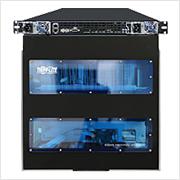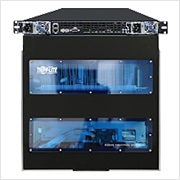
“This technology gives colocation operators unprecedented abilities,” said David Posner, Tripp Lite’s Director of Product Marketing, Connectivity. “They can control connections on a reliable schedule. They won’t have to guess which cables are being utilized and which ones are idle.”
CHICAGO (PRWEB)
November 14, 2019
Tripp Lite, a world-leading manufacturer of power protection and connectivity solutions, has introduced cutting-edge products for automating physical cross connections in data centers. Robotic Fiber Panel Systems employ robotic latching and remote management to optimally set fiber connections between network equipment.
Data centers and colocation facilities are scaling up to provide better data access, or “Bandwidth on Demand” (BWoD), to customers. At the infrastructure level, this means a denser layout with more layer 1 physical connections between equipment. Relying solely on hands-on management of these connections is an increasingly inefficient practice, but Robotic Fiber Panel System automation provides a solution.
“This technology gives colocation operators unprecedented abilities,” said David Posner, Tripp Lite’s Director of Product Marketing, Connectivity. “They can control connections on a reliable schedule. They won’t have to guess which cables are being utilized and which ones are idle.”
Robotic Fiber Panel Systems can typically re-configure a connection in 50 seconds, as opposed to the hours or days it often takes for on-site network engineering to arrive. “And Robotic Fiber Panel Systems are more secure,” Posner continued. “The more hands-on switching that occurs, the more your infrastructure is at risk of error or physical damage. This is a fast and precise alternative.”
Any organization that provides large-scale data services can take advantage of the flexibility Robotic Fiber Panel Systems incorporate into their infrastructure. A model for singlemode fiber cabling and one for multimode fiber cabling are available. They can be configured to accommodate almost 500,000 ports, all optical signals and all network protocols. This allows operators to adapt to new technologies without equipment overhauls.
This flexibility translates into cost savings as well. A more efficient infrastructure has less under-utilized equipment, which means less equipment to purchase, power and maintain.
Key Benefits of Robotic Fiber Panel Systems:
-
Efficient provisioning of physical connections - Secure remote management and audit capabilities
- Faster, more effective disaster recovery
- Lower CAPEX and OPEX
- Passive, purely optical connections that are unaffected by power outages
- Scalability for the future
Learn more about Tripp Lite’s Robotic Fiber Panel Systems at http://www.tripplite.com
Share article on social media or email:

